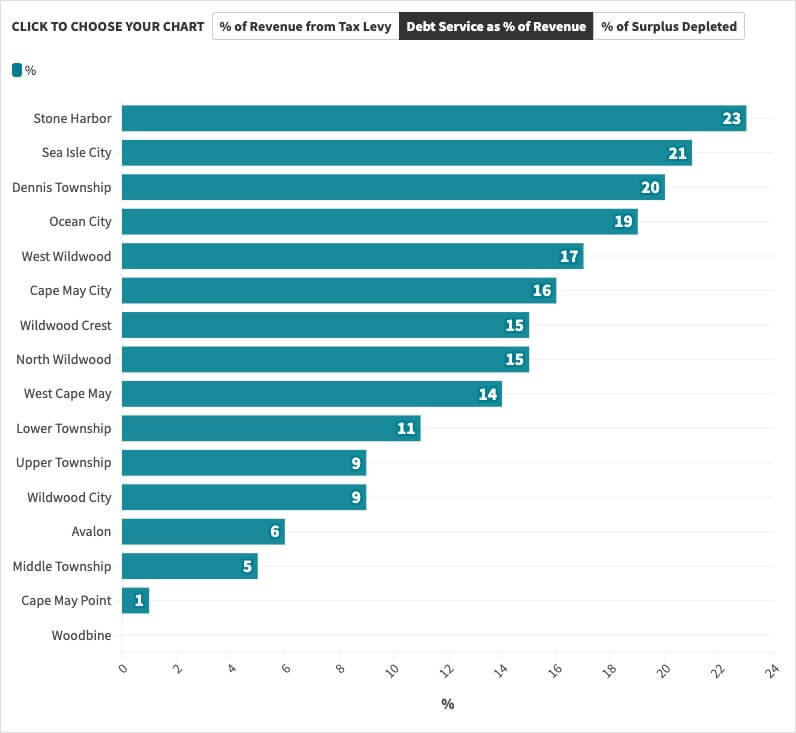STONE HARBOR – Stone Harbor is a community of almost $5 billion in assessed property valuation. State data would put the true value of real property in the borough at $7.5 billion. With this kind of ratable base, the borough has a strong foundation for its financial health.
Stone Harbor’s 2023 budget was similar to others in the county in terms of its 3.4% local purpose tax rate increase. Thirteen of the county municipalities had tax rate increases this year, as they wrestled with inflation, rising worker health premiums, the loss of federal pandemic relief dollars and, for many, ongoing demands for flood mitigation projects.
Click here to read about all 16 municipal budgets in Cape May County.
A deeper look at the Stone Harbor budget, however, shows some vulnerabilities that have persisted in its budgets for several years now.
Debt
The borough has the highest ratio of debt service payments to total revenue in the county. Debt service absorbs 23% of the total revenue of the general fund.
By way of comparison, debt service as a percentage of general fund revenue is 16% in Cape May, 6% in neighboring Avalon, and 15% in North Wildwood, its southern neighbor. This is particularly striking since Stone Harbor’s annual debt service of $5 million is against a general budget of only $21.5 million, the smallest general fund budget of the county’s island communities, with the exception of West Wildwood, Cape May Point, and West Cape May.
Stone Harbor has few alternative sources of revenue to offset taxpayer dollars.
The Stone Harbor Property Owners Association (SHPOA) has raised the capital debt issue for several years now. Prior to the pandemic, SHPOA was urging the borough to develop a 10-year budget model, especially for capital spending. Such an endeavor was said to be underway a number of times, but no such document has yet surfaced in any public forum.
The concern expressed by SHPOA was that capital debt was already high without yet having absorbed likely spending for flood mitigation. A massive pump station plan for 93rd Street fell through when estimated costs surpassed $11 million.
Now, a much less expensive strategy using valves to cut off inflow of bay waters through the borough’s outflow pipes is being tested. If pump stations of some sort must still be constructed, and Borough Administrator Manny Parada has said publicly that such a need is likely, debt levels may need to rise.
SHPOA submitted an analysis that projected as much as a 46% increase in the local purpose tax rate largely based on an expectation that significant initiative in sustainability projects will be needed in the period from 2023 to 2027. The analysis projects a significant increase in debt service. That analysis was done when the 93rd Street pump station was still a viable project.
Whether the SHPOA analysis will hold up is hard to discern since it was never discussed by the council after it was submitted to the governing body. In the absence of a multiyear plan for sustainability that defines projects and their estimated expenses, it is hard to determine debt levels within the context of a relatively modest overall revenue base.
The borough had a Flood Mitigation and Storm Sewer Master Plan done in 2022. Some strategies outlined in that plan may be subject to change since it was done while the 93rd Street pump station was still a contemplated project. The plan does not substitute for a long-range financial analysis of the likely necessary investment the borough may have to make and the impact of that investment on debt levels.
Alternative Sources of Revenue
The Stone Harbor tax levy, plus surplus used in the 2023 budget, represents 83% of total revenue. In the pre-pandemic 2022 budget, that number stood at 82%. In short, the borough has few alternative sources of revenue to offset taxpayer dollars.
The borough’s largest nontax contributors to general fund revenue are $1 million in beach fees, $470,000 in fees and permits, and $420,000 in parking meter revenue. One potential source of revenue the borough has not employed is the up to 3% tax that can be levied against hotel and short-term rental occupancy.
The borough has also elected not to make use of self-financing utilities separate from the one it has for water and sewer, which is budgeted in 2023 at $5.6 million. Towns that make use of the utilities do so to structure user fees, so they cover designated expenses without recourse to tax dollars. Admittedly, Stone Harbor is not alone in its reluctance to make use of utilities for other activities beyond water and sewer.
Surplus
Many of the county’s island communities have general fund surplus balances that significantly exceed the $4.1 million surplus listed in Stone Harbor’s 2023 budget. Stone Harbor’s surplus balance is the lowest among the island resort communities, with, again, the exceptions being West Wildwood, Cape May Point, and West Cape May.
An error in budgeting in 2020 resulted in the need for an emergency authorization, which required the borough to raid its cap bank in the subsequent year’s budget to avoid the need for a state waiver for its local purpose tax rate increase. The borough’s cap bank is again being built up, but it stands at a level below most of its peer communities.
Conclusion
The point is not that Stone Harbor doesn’t have solid financials. Any small borough with a relatively low tax rate and its level of ratables is not in financial trouble. However, flexibility is an issue one might explore.
With an existing debt level that absorbs almost one in four revenue dollars, a relatively modest surplus that is the norm for the borough over the last 10 years, and with few alternative sources of revenue and no public discussion of the council focused on identifying such sources of revenue, the issue may be how flexible the budget is if the borough is faced with the need to invest in expensive sustainability projects or is presented with some other unexpected but significant demand on its resources.
Contact the author, Vince Conti, at vconti@cmcherald.com.








